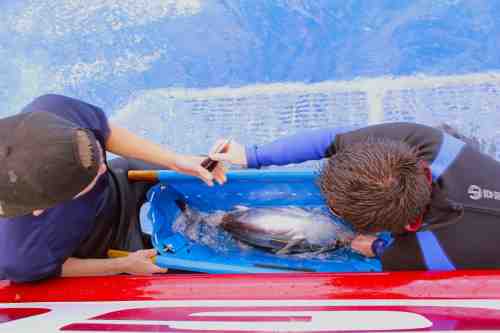
Report Date:
http://www.fishingvideos.com"As scientists, anglers and passionate fans of Pacific bluefin tuna we live for day like we have had here on Shogun in the past 24 hours. Our mission: to collect tunas for studies back at our home laboratory--the Tuna Research and Conservation Center (TRCC). We arrived in the area where fishing reports had been excellent and proceeded from dawn to dusk to have a wide-open bluefin bite. And this time, for the first time in years, we were more than prepared. The Stanford University team had programmed over 100 tags prior to coming out on the trip and anticipation was high.
This year we had some older TAG team members- from our lab- including Tag-a Giant and TRCC technicians Robbie Schallert & Alex Norton, Stanford technician for our Gulf Oil spill team Ben Machado. Also on board Stanford graduate students Dane Klinger and Dan Madigan, and undergraduates who had interned with the TRCC this summer including undergraduates Natalie, Ethan, Sarah, Andrew and James.
Captain and Professor Norm put us in a great spot to drift and before sun up Dan Madigan hooked up. This year to prepare with our younger team, we had held a tagging class, gone over the cradling of fish on the swim step. Sure enough chaos occurred during the first fast bite when the team barely had their feet wet. We put the fish that first appeared as yellowfin into the side wells and quickly filled to capacity. We then heard the first call from the crew of bluefin! The tagging team (Barb, Robbie, Dr. Joe Bonaventura) went into the action, tagging 7 yellowfin.
The bite slowed down and we moved on. Within an hour, Norm glanced and viewed a sonar hit that was extremely interesting; the fish were down on the thermocline in the 'feed layer' or deep scattering layer the area I call the peanut butter of the ocean, filled with small crustaceans and squid. From the moment we stopped on the sonar school, until 6 PM we had steady bluefin action that led to what I think may be the highest single electronic tagging stop for bluefin tuna: 96 archival tagged bluefin (all with one tagging station!).
In addition, we filled up the slammer with bluefin. Scientific samples were taken by Dan and Ben from a handful of bluefin to discern isotopic signatures (think you are what you eat) and to also determine from where the fish had come (signatures from the open sea are lower in numerical value than in the productive California Current). I was a bit surprised to see Captain Bruce, Randy and Tommy admiring an albacore as if they had not seen one in awhile. This was the first Albacore of the season, remarkable, given it happened the third week in August. I thought the albacore were quite skinny suggesting they had come from offshore.
History was made here today aboard the Shogun-by the end of the day, we had collected all the bluefin required for the TRCC this year, tagged 103 tunas and released another 50 more. All and all, we could have tagged 200 bluefin today! Too bad we did not have more conventional and electronic tags! The fish were very young, potentially new arriving fish on the west coast. From prior tagging we know that this year class will be retentive to the California current and provide super fishing on a 30lb 3rd year fish next season so let's hope their survival will lead to more knowledge and great fishing.